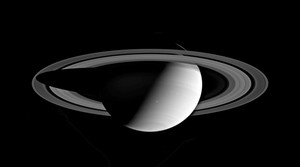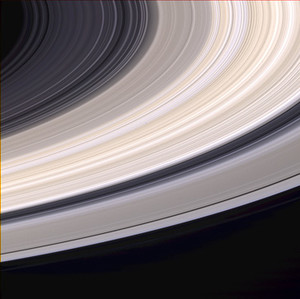The sixth planet from the Sun, orbiting every 29.45 years at a mean distance of 1426.7 million km (9.54 au). Its mean opposition magnitude is between +0.7 and −0.3, depending on the tilt of the rings towards us, the faintest of the five planets known since antiquity. Saturn is the most flattened in shape of all the planets, with an equatorial diameter of 120 536 km and a polar diameter of 108 728 km. It is also the least dense of all the planets (0.69 cm3) and the only planet less dense than water. The rotation period of the visible surface ranges between about 10 h 14 m near the equator and 10 h 40 m at 60° south. The rotation of the planet’s interior, derived from observations of Saturn’s radio emissions by the Cassini probe, is 10 h 47 m 6 s.
Saturn
Physical data
Diameter (equatorial)
Oblateness
Inclination of equator to orbit
Axial rotation period (sidereal)
120 536 km
0.098
26°.73
10.233 hours
Mean density
Mass (Earth = 1)
Volume (Earth = 1)
Mean albedo (geometric)
Escape velocity
0.69 g/cm3
95.16
764
0.47
36.1 km/s
Orbital data
Mean distance from Sun
106 km
au
Eccentricity of orbit
Inclination of orbit to ecliptic
Orbital period (sidereal)
1426.725
9.537
0.054
2°.5
29.447 years
Saturn has a thick atmosphere composed of about 96% hydrogen and 3% helium (molecular percentages), with traces of methane and ammonia. The temperature near the top of the atmosphere is around −190°C. Internally, Saturn is thought to possess a rocky high-temperature core, perhaps containing iron, about 20 000 km across. This is possibly surrounded by a layer of icy materials 5000 km thick, and a layer of metallic hydrogen and helium over 10 000 km thick. Convection currents within the conductive hydrogen layer are probably responsible for Saturn’s magnetic field, which has an equatorial field strength of about 2 × 10−5 tesla, somewhat weaker than the Earth’s. Surrounding this layer is normal molecular liquid hydrogen and helium, which gradually merges into a gaseous layer near the visible surface. Like that of the Earth, Saturn’s magnetic field is oriented parallel to the planet’s spin axis, but with opposite polarity.
Like Jupiter, the visible surface of Saturn is crossed by dark belts or bands of cloud, with bright zones between, although the atmosphere is generally calmer than Jupiter’s. Dark and bright spots occur, but are fainter and far less frequent than on Jupiter. Wisps and festoons suggestive of turbulence in the atmosphere are visible on spacecraft images. There is a ‘jet stream’ in the equatorial zone, where the rotation period is nearly half an hour faster than elsewhere. There are no long-lived features, but occasional spectacular outbursts of huge white spots occur in the equatorial zone. The first to be well-observed was in 1933 August, soon spreading over much of the equatorial zone. Similar outbreaks occurred in 1960 March, 1990 October, and 2010 December.
Saturn’s most distinctive feature is its bright rings, which consist of particles ranging in size from micrometres to metres and are composed primarily of water ice and rock. They have an albedo of up to 0.60, far higher than any other planetary rings. Through telescopes, three main rings are visible: the outer A Ring, 14 600 km wide, extending out to 136 800 km from Saturn’s centre; the central B Ring, the brightest, 25 500 km wide; and the much fainter inner C Ring or crêpe ring, 17 500 km wide. Darker spokes are faintly visible on the B Ring. Between the A and B Rings lies a prominent gap, the Cassini Division, and the A Ring itself is divided by the Encke Gap and the Keeler Gap. Space probes have revealed that every ring has dozens of tiny subdivisions.
There are a further four named rings: the D Ring, which lies inside the C Ring; the narrow F Ring, which lies outside the A Ring; the more distant G Ring; and the outermost, the wide and diffuse E Ring. The innermost edge of the D Ring lies 67 000 km from the centre of Saturn, while the outer rim of the E Ring is 480 000 km from Saturn’s centre. The E ring consists of microscopic particles of water ice, silicates, carbon dioxide, and ammonia emitted by cryovolcanoes at the south pole of the moon Enceladus. The origin of the other rings is not fully understood. One possibility is that they were formed by breakup of a former moon, or are building blocks of a moon that never formed. On the other hand, data from the Cassini mission suggest that the C ring is only 15 to 100 million years old, so they may have formed relatively recently, or are renewed in some way. Despite their great extent, the rings are extremely thin, a few hundred metres at most, and disappear in all but the largest telescopes when edgewise-on to the Earth, which happens every 15 years or so.
Saturn has over 60 known satellites the largest of which, Titan, is bigger than the planet Mercury.
 http://hubblesite.org/news_release/news/2001-15/22-saturn/2001
http://hubblesite.org/news_release/news/2001-15/22-saturn/2001
The sixth planet from the Sun, and the second largest in the Solar System, encircled by bright and easily visible equatorial rings. Viewed through a telescope it is ochre. Its polar diameter is 12 000 km smaller than its equatorial diameter, a result of its fast rotation and low density, the lowest of any planet. Its mass is 95 times that of the Earth, and its magnetic field 1 000 times stronger.
mean distance from the Sun 1.427 billion km
equatorial diameter 120 500 km
rotational period 10 hours 14 minutes at equator, 10 hours 40 minutes at higher latitudes
year 29.45 Earth years
atmosphere visible surface consists of swirling clouds, probably made of frozen ammonia at a temperature of −170 °C, although the markings in the clouds are not as prominent as Jupiter's. The Voyager probes, visiting in 1980 and 1981, found winds reaching 1 800 kph
surface Saturn is believed to have a small core of rock and iron, encased in ice and topped by a deep layer of liquid hydrogen
satellites Over 30 known moons. The largest moon, Titan, has a dense atmosphere
rings The rings visible from Earth begin about 14 000 km from the planet's cloudtops and extend out to about 76 000 km. Made of small chunks of ice and rock (averaging 1 m), they are 275 000 km rim to rim, but only 100 m thick. The Voyager probes showed that the rings actually consist of thousands of closely spaced ringlets, looking like the grooves in a gramophone record
From Earth, Saturn's rings appear to be divided into three main sections. Ring A, the outermost, is separated from ring B, the brightest, by the Cassini division, named after its discoverer Italian astronomer Giovanni Cassini (1625–1712), which is 3 000 km wide; the inner, transparent ring C is also called the Crepe Ring. Each ringlet of the rings is made of a swarm of icy particles like snowballs, a few centimetres to a few metres in diameter. Outside the A ring is the narrow and faint F ring, which the Voyagers showed to be twisted or braided. The rings of Saturn could be the remains of a shattered moon, or they may always have existed in their present form.
The Cassini space probe, developed jointly by NASA and the European Space Agency, was launched in October 1997, and went into orbit around Saturn in July 2004.

Cassini captured this image of Saturn from a distance of 5 million km on 13 July 2004. The line separating day from night indicates the tilt of its axis and that it is summer in its southern hemisphere.
Credit: NASA

The rings of Saturn taken by Cassini at a distance of 6.4 million km from the planet.
Credit: NASA
http://solarviews.com/eng/saturn.htm How many rings does Saturn have? How many satellites? Find out the answers to these questions and more at this site, which also features a video of a storm in the planet's atmosphere and information on the international Cassini mission to Saturn and Titan.
The sixth planet in the solar system, distant 9.52 AU from the Sun. Its radius is 60 000 km, density 704 kg/m3, mass 95 × Earth mass, volume 833 × Earth volume, and it has an equatorial inclination to the ecliptic of 29°. An outer zone of hydrogen and helium is underlain by a zone of metallic hydrogen, around an ice–silicate core. It has 62 satellites and is famous for its ring system. The orbiter Cassini studied Saturn’s atmosphere, its mission ending on 15 September 2017, when it descended into the planet’s atmosphere.
- complex plane
- complex potential
- complex system
- complex twins
- compliance costs
- component
- component(of a compound statement)
- component(of a graph)
- component(of a vector)
- component part
- components of variance model
- component-stratotype
- component vectors
- component video
- componentwise
- COM port
- com port
- composite
- composite cable
- composite commodity
- composite conductor
- composite fault-line scarp
- composite fruit
- works
- works council